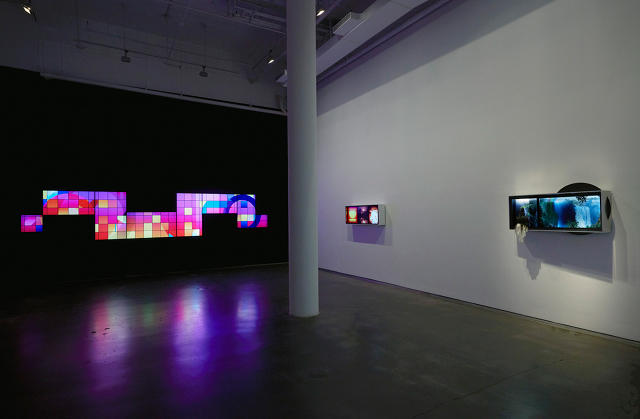For an artist who uses robots to carve marble and 3-D printers to build landscapes, the work of Yorgo Alexopoulos is surprisingly accessible. That's by design. "It's about creating an environment that's very universal, that anybody can come into and respond to my work," he says. "By seeing it, they ultimately getting a sense of who I am and what I am about and also unravel a bit about themselves."
Alexopoulos has a mixed-media installation called Act of Nature on view at the New York City gallery Bryce Wolkowitz and in the works on view he explores this notion of universality through conveying archetypal subjects—like landscapes—in unconventional ways. For example, Split Swell—a digital animation of rolling waves split across seven LED screens set into deep steel frames—speaks to a deep-seated cultural link to water.
"It's symbolic of everything from Odysseus to the Epic of Gilgamesh and Noah's Ark—almost any hero myth has an ocean crossing," he says noting that it also alludes to travel and being outside of our comfort zones. "Viewers of my work bring all sorts of different sensibilities and subjective interests to an exhibit so I think for any artist or any successful work of art there has to be some sort of common language or collective thing that the viewer can grab onto. If I put a mountain in front of someone or a tree or an ocean, I'm going to immediately have a mental handshake with them."
Alexopoulos came up in the 1980s as a graffiti artist and documentary photographer in Southern California before heading to the School of the Art Institute of Chicago from which he graduated in 1995. He moved to New York afterward and became immersed in digital design tools like Photoshop and Illustrator and began drawing with those programs; eventually he used the computer exclusively to create his works. He then went on to create the visual effects for the 2002 documentary The Kid Stays In the Picture using film stills. The process of deconstructing the photos, separating them into foreground, middleground, and background then layering them with other artwork was somewhat of a creative breakthrough and he began to use a similar approach with his own archive of illustrations, photographs, paintings, and video. Using After Effects, an Adobe program, he could bridge digital and traditional mediums.
"One of the things that I'm interested in with any artwork is process," he says. "Though the ultimate form of a lot of the work I've done over the last five to six years is light and video, the content in the installations is about the coming of age of the art making process. I'll shoot film of, say, a mountain, and I'll photograph the mountain, and I'll paint a watercolor of the mountain. Then I'll combine all of those into a video that then has a meta narrative the takes you on a visual journey through all of those different processes."
Recently, his work has taken on a more tactile approach to draw viewers further in. For example The Way to the Sky—a piece in his exhibition—features a high-definition animation of a tropical landscape. The image of a craggy cliff transitions into a physical representation of the scene made from a 3-D printer before jumping out of the metal frame courtesy of a piece of Thassos marble carved using a Kuka robot.

"First I have to have a concept and then once I have a concept, then I think of the effect I want it to have on someone, and then I figure out how do I get the effect to happen," Alexopoulos says about experimenting with different mediums in his work. Though he does work with emerging technology and has been a pioneer in media art, he rarely starts with a tool in mind. "Ultimately a lot of artworks that work the other way around end up being contrived. Typically when you see a new artistic technology come to light, you see some commercial company that's been hired to do something with it. It doesn't go into the realm of art, it doesn't have any mystery, and it doesn't have any symbolism to it. I don't really work that way. I work like an artist would work where there's a concept and an effect you want to have, and you use a medium that gets you there."
For Alexopoulos, the goal is to transport viewers. Gazing into one of his constructed landscapes or seeing one of his videos synchronized over a tessellation of screens does transport you mentally. (I saw an adaptation of Ocean Views at a design fair and it was so hypnotizing and cathartic that I completely tuned out the crowd behind me.)
"Anytime you make a work of art, you want to reach your audience so it's important to create an artwork that is universal enough that you want to actually make that connection with somebody," he says. "You don't want the artwork to be esoteric. If you make it extremely esoteric then you're not going to make that connection, and you're not going to be able to communicate."
See Act of Nature at Bryce Wolkowitz until June 11, 2016.